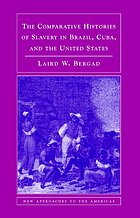
Perhaps no group left a stronger social and cultural impact on colonial Cuba than people of African descent. The vast majority of scholarship on colonial black Cuban histories centers on slavery. Emerging in earnest in the mid-twentieth century, North American scholarship on Cuban slavery responded to a series of national and international developments in the African diaspora, in Cuba specifically, and within the US academy. World War II unleashed a wave of African American civil rights activism in the United States, which in turn thrust race issues to the fore in US scholarship. The various 1950s UNESCO studies of race in Brazil (e.g., Race and Class in Rural Brazil, edited by Charles Wagley), in part conceived as an effort to diagnose the historic roots of racial unrest in the United States, galvanized interest in what was widely perceived to be the roots of the local idiosyncrasies of racism across the Americas: slavery. Moreover, specific academic developments in Cuba inspired the rise of a body of scholarship on slavery that was heavily oriented toward the long nineteenth century, a pattern mirrored by US historians. The 1947 translation of Cuban anthropologist Fernando Ortiz’s Cuban Counterpoint: Tobacco and Sugar offered North American scholars a strong foundation for their own studies of sugar and slavery in Cuba, foregrounding the nineteenth century as the main focal point. These developments together helped produce an entire generation of research on comparative slavery and race relations, with the Cuban case as one of the main pivot points.
Research on slavery in Cuba only gained momentum in the 1960s, when the Marxist-inspired methodology of “history from below” took root in the US academy. Indeed, early North American scholarship approached slavery in Cuba through a comparative framework, usually seeking to critique the severity and persistence of racism in the United States by depicting plantation slavery and subsequent race relations in Cuba as inherently more benign than they were in the United States. Frank Tannenbaum’s classic Slave and Citizen: The Negro in the Americas paved the way for an entire generation of comparative slavery studies, with particular relevance to Cuba, as Alejandro de la Fuente has pointed out in his Law and History Review article “Slave Law and Claims-Making in Cuba: The Tannenbaum Debate Revisited.” For example, in Slavery in the Americas: A Comparative Study of Virginia and Cuba, Herbert S. Klein argued that people of African descent achieved greater social integration in Cuba than they did in the United States, in part because of the relative flexibility of Cuban slavery. In contrast to early comparative studies, more recent works offer a much more critical assessment of the institution on the island within its broader Atlantic context. For example, Laird W. Bergad expands the comparative framework to include Brazil in The Comparative Histories of Slavery in Brazil, Cuba, and the United States, in which he emphasizes the parallel persistence of racism even after abolition in all three countries.
Like the above studies, most work on Cuban slavery focuses on the nineteenth century, when the late-eighteenth-century rise of King Sugar catalyzed Cuba’s transformation into a slave society. Indeed, the 1976 translation of Manuel Moreno Fraginals’ seminal work on the sugar economy, The Sugarmill: The Socioeconomic Complex of Sugar in Cuba, 1760-1860, only cemented the salience of the nineteenth century for studies of sugar and plantation slavery. One of the most exemplary works in this vein was Franklin W. Knight’s Slave Society in Cuba during the Nineteenth Century, which posited the rise of the sugar industry as the primary development ushering Cuba’s transition from a society with slaves to a slave society. Similarly, among the most important demographic studies of Cuban slavery is The Cuban Slave Market, 1790-1880, by Laird W. Bergad, Fe Iglesias García, and María del Carmen Barcia. The nineteenth-century focus continued with the translation of Gloria García Rodríguez’s Voices of the Enslaved in Nineteenth-Century Cuba, which offers students an excellent assortment of primary source documents on Cuban slavery, including ones produced by enslaved people themselves.
 The comparative histories of slavery in Brazil, Cuba, and the United States
by
The comparative histories of slavery in Brazil, Cuba, and the United States
by